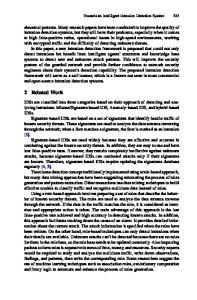Explanation Framework for Intrusion Detection
Machine learning and deep learning are widely used in various applications to assist or even replace human reasoning. For instance, a machine learning based intrusion detection system (IDS) monitors a network for malicious activity or specific policy viol
- PDF / 6,014,086 Bytes
- 129 Pages / 476.22 x 680.315 pts Page_size
- 36 Downloads / 394 Views
Jürgen Beyerer Alexander Maier Oliver Niggemann Editors
Machine Learning for Cyber Physical Systems Selected papers from the International Conference ML4CPS 2020
Technologien für die intelligente Automation Technologies for Intelligent Automation Band 13 Reihe herausgegeben von inIT – Institut für industrielle Informationstechnik Lemgo, Deutschland
Ziel der Buchreihe ist die Publikation neuer Ansätze in der Automation auf wissenschaftlichem Niveau, Themen, die heute und in Zukunft entscheidend sind, für die deutsche und internationale Industrie und Forschung. Initiativen wie Industrie 4.0, Industrial Internet oder Cyber-physical Systems machen dies deutlich. Die Anwendbarkeit und der industrielle Nutzen als durchgehendes Leitmotiv der Veröffentlichungen stehen dabei im Vordergrund. Durch diese Verankerung in der Praxis wird sowohl die Verständlichkeit als auch die Relevanz der Beiträge für die Industrie und für die angewandte Forschung gesichert. Diese Buchreihe möchte Lesern eine Orientierung für die neuen Technologien und deren Anwendungen geben und so zur erfolgreichen Umsetzung der Initiativen beitragen.
Weitere Bände in der Reihe http://www.springer.com/series/13886
Jürgen Beyerer · Alexander Maier · Oliver Niggemann Editors
Machine Learning for Cyber Physical Systems Selected papers from the International Conference ML4CPS 2020
Editors Jürgen Beyerer Institut für Optronik, Systemtechnik und Bildauswertung Fraunhofer Karlsruhe, Germany
Alexander Maier MIT Fraunhofer IOSB-INA Lemgo, Germany
Oliver Niggemann Helmut-Schmidt-Universität Hamburg Hamburg, Germany
ISSN 2522-8587 (electronic) ISSN 2522-8579 Technologien für die intelligente Automation ISBN 978-3-662-62746-4 (eBook) ISBN 978-3-662-62745-7 https://doi.org/10.1007/978-3-662-62746-4 © The Editor(s) (if applicable) and The Author(s) 2021. This book is an open access publication. Open Access This book is licensed under the terms of the Creative Commons Attribution 4.0 International License (http://creativecommons.org/licenses/by/4.0/), which permits use, sharing, adaptation, distribution and reproduction in any medium or format, as long as you give appropriate credit to the original author(s) and the source, provide a link to the Creative Commons license and indicate if changes were made. The images or other third party material in this book are included in the book’s Creative Commons license, unless indicated otherwise in a credit line to the material. If material is not included in the book’s Creative Commons license and your intended use is not permitted by statutory regulation or exceeds the permitted use, you will need to obtain permission directly from the copyright holder. The use of general descriptive names, registered names, trademarks, service marks, etc. in this publication does not imply, even in the absence of a specific statement, that such names are exempt from the relevant protective laws and regulations and therefore free for general use. The publisher, the authors and the editors are safe to assume that the advice and infor
Data Loading...











